Chickens for the Orchard (Part 3)
- Bill Wilson
Part 3: 8-13 Weeks of Age (As Adventurers)
Part 2: 4-8 Weeks of Age (As Kids)
Part 1: 0-4 Weeks of Age (As Chicks)
Original Objective: Raise some chickens for food and to also help with insect, grass and weed control in our 2-acre organic community orchard…!!!
New Objective: Keep our birds alive so that we will have some sort of chicken harvest. Ouch!
 |
| Over the last 5 weeks we have been stretched to learn more about the habits and characteristics of these inquisitive and entertaining birds. They have been doing a fine job of keeping the orchard grass under control (we have only mowed once this year) and as a result, the amount that we have paid for chicken feed is significantly less than if they were confined to a small area. This was working really well. |
 |
| When they were still quite small we could rely on them to gather up whenever we stopped by to check on them. All that Hayden and/or Zach (another of our summer work/study interns) had to do was head for the feed bin and the chickens would all come running. It was a good way to keep an eye on them daily. |
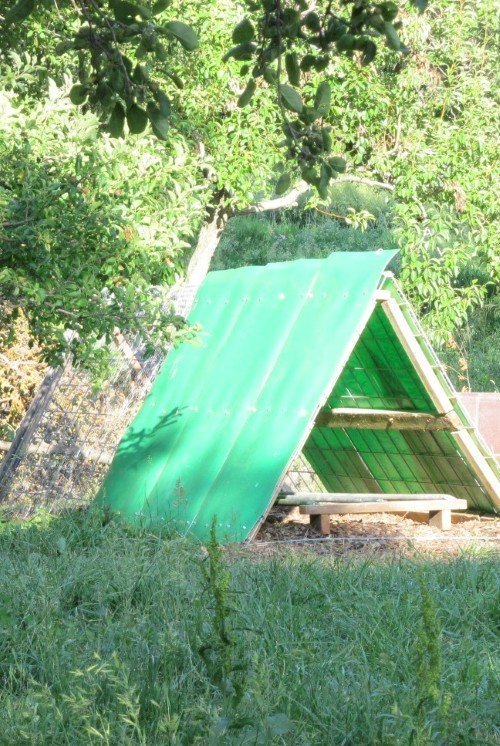 |
|
And every evening we could count on the flock returning to their chicken coop as darkness set in. It was such a joy to watch them find their own way into the coop that occasionally, Becky and I would head down a bit early with a glass of wine and just watch them. It was very peaceful. And right from the beginning, we somewhat bonded to them, and they to us. |
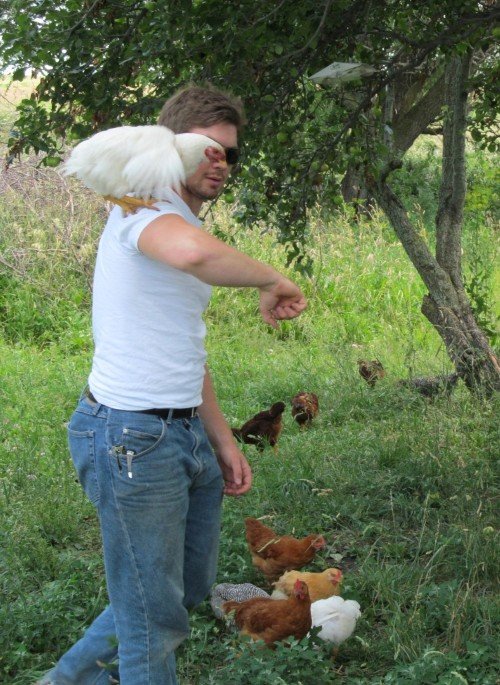 |
| We hit a bump in the road around week 10 when we had several cool, rainy days immediately followed by heat and high humidity. The combination proved to be stressful and we lost a handful of birds. We learned just how important it is to keep them comfortable, clean and dry to maintain a healthy flock. |
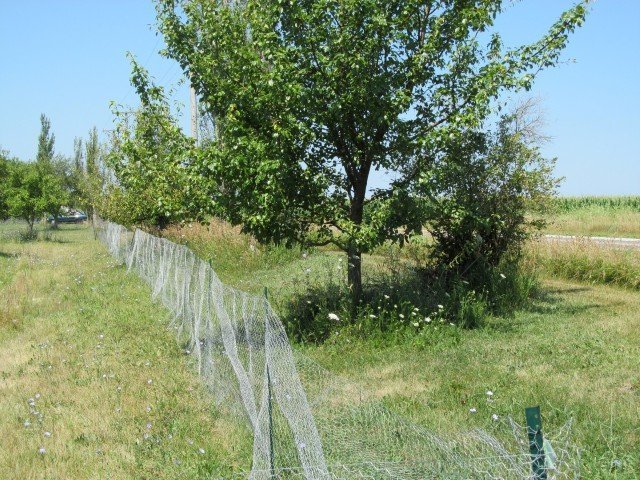 |
| Shortly after that challenge was solved, our adventurous little friends starting wandering into the road. For weeks prior they paid no attention to it, then one day, they started visiting it regularly. We quickly erected a security fence but had lost another handful to speeding cars and trucks before we could complete it. This was unexpected as we let our 18 laying hens roam the orchard freely last year and they never made it to the road. Now we know better. |
| Then around week 11 things really started to change… |
 |
| As the chickens got older and bolder, a few of them started to roost on top of the coop in the evening rather than going into the coop. Fortunately, once it gets dark, the chickens also become very docile. So all that we had to do was pick them up and set them into the coop. No Problem. |
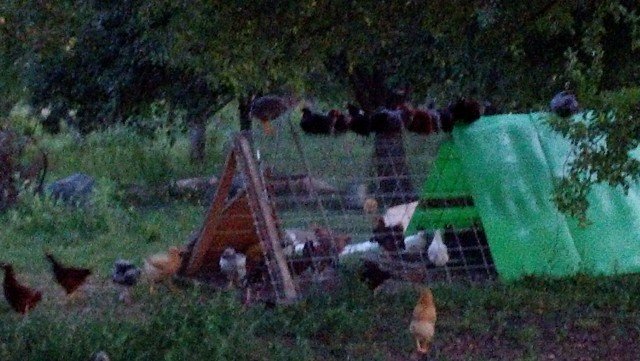 |
| The next evening however there were 6 on top, the next night 10, then 13, then 18. Now putting them to bed started to become a real chore. We also started to notice that there were some chickens missing. We scoured the orchard and found no signs of predator pressure nor any chicken remains. They were just gone…!!! Hummmm….. |
|
The likely possibilities is that predators (coyotes? Owls?) were carrying them off to eat their catch in privacy. Or the chickens were following the creek away from the orchard only to pop their heads up into industrial agriculture land down stream. This is not a safe place for a chicken. |
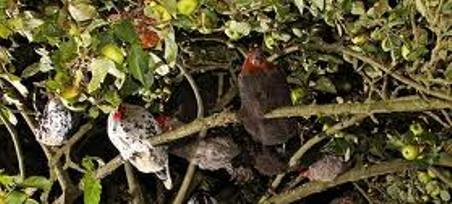 |
|
Shortly thereafter, our growing chickens really found their wings and started to roost up in the branches of the apple trees. There was now no-way to capture them at night so we were forced see how they might fare against predators on their own. It looked hopeful at first but then we started to find the remains of one, maybe two chicken per night. We soon realized that we needed to figure out a way to protect them better day and night if we hoped to have any chickens left by the fall. |
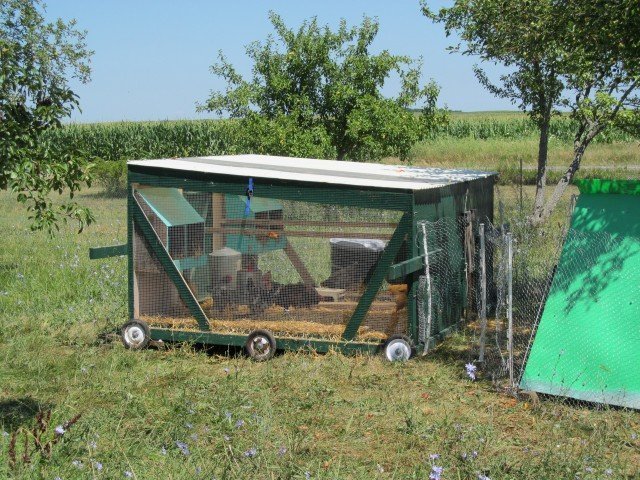 |
|
It took us several days, but we came up with a plan. We brought over our laying hen coop from last year (very secure, high and dry, and not in use) and connected our original 150-foot chicken wire fence to it. We ran the fencing around a couple of healthy trees to be certain that the chickens had shade and additional shelter. We also put their triangular coop inside the fence at the drip-line of a tree where we intend to put in an understory of perennial plants. Once again, we will let the chickens prepare and fertilize a bed for us. |
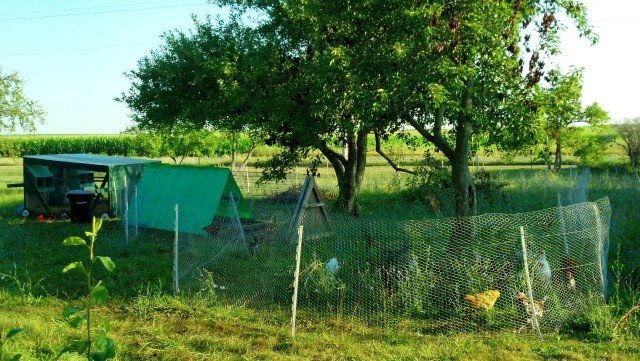 |
|
Once the new chicken camp was set up, a team of of us captured all of the chickens in one evening (before they roosted) and put them into their new home. We decided to clip their flight feathers on one wing (commonly done – does not hurt them at all) so that they can no longer fly up and roost in the trees at night nor fly over the 4-foot fence. They didn’t seem to mind the clipping and it has really worked. Not one chicken has flown the coop since we did this about 5 days ago. |
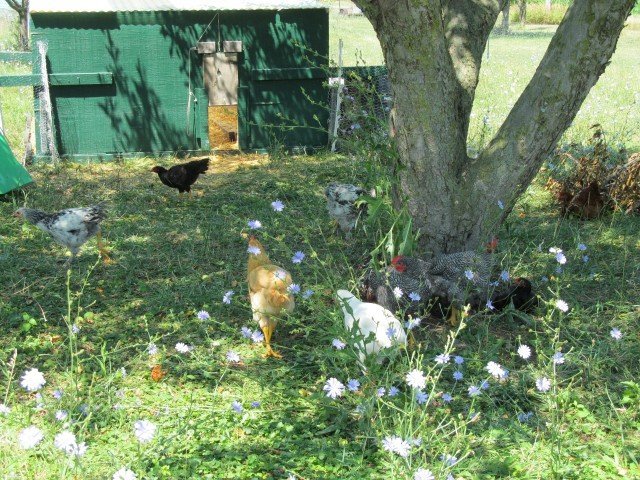 |
|
Needless to say, our remaining flock of birds are beautiful and growing slowly with their healthy diet and exercise (the largest are about 4 lbs. now). We will have to move the pen about twice a week as they eat down the grasses, but if it keeps them safe, we will gladly do it. It appears that for these heritage breeds, roaming the orchard will have to end about the time they start to fly and roost. Then we will graze them around the orchard in a protected fence to minimize predator pressure and to keep them from wandering away. |
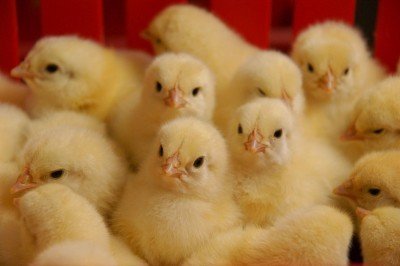 |
| However, to get some chicken to meet the requests of our fellow coop members, we have ordered another 100 chicks, this time the Cornish Rocks which are one of the more-common, faster-growing chickens. They should reach full weight in about 10 weeks. |
|
If there is one thing that has been reinforced in us, it is the confirmation of just how much experience, skill, and attention to detail one must have in order to raise large quantities of food when choosing to work with nature rather than against her. It is also important to remember just how much more time it takes to put an activity that requires two or three visits a day when that activity is happening in what we call ‘Zone 4’ in permaculture. We are walking or riding our bikes back and forth way too much. Our hats are off to all of you who care for the land and our fellow creatures in a conscious and compassionate way. We will post again in another month…. Living, Loving and Learning… Bill Wilson and the Chicken Crew |
|
Interested in visiting Stelle and seeing our chicken venture up close? CSC Open House in Stelle, IL 1. Introduction to Stelle: 10:00 – 11:00 (Free – We will start promptly.)
2. Community walk-about: 11:00 – 12:00 (Free)
3. Lunch ($10)
4. Learn about and visit the Chickens: 1:30 – 3:00 ($15 Adults – $5 Children 15 and under)
We will quickly tour the CSC land and review the Permaculture Plan too.
I will be your host for the day and our interns will assist with the afternoon seminar.
Hope to see some of you…. Bill
Call 815-216-4124, message or text us at 815-782-22162204 or email CSC () to register.
Here are the Directions and Maps to Stelle
|

6 thoughts on “Chickens for the Orchard (Part 3)”
Bill, I greatly enjoyed this chicken account, as well as the hugleculture description. While I was watching these via the CSC newsletter, I watched a number of the other videos that are available there. Was really impressed with the compacting of a great deal of Permaculture information cited in them. Thanks for expanding your education of your viewers! Sincerely, Carroll
You are welcome Carroll. This is inspiring and important information… need to get it out there. Cheers… Bill
Bill, I just loved the time you took share the photo journal and your personal experiences raising the chickens! I learned so much. I wonder if someday I’ll need to apply this knowledge!
Hugs
Thanks Sis… That’s precisely why we are sharing our journey. If what we learn help others have greater success… perfect. I also hope it will encourage some to try raising some chickens for themselves when the time is right.
Big Brother… Bill (Seriously… Jane is one of my sisters)
I currently have 9 layers raised from 1 day old chicks that I allow to free range around our property (30 acres) by day. You really do need to keep a close eye on them for predation and we have chosen to keep them in zone 1/2 for just that reason. (I realize this is harder to do with more chickens.) Surprisingly, our flock never seems to want to go farther than around the house and back to the coop – about 1/2 acre of free roaming at the most. The most important point is that they have some cover to run to when in open space and never feel vulnerable to predation from above. They are very rarely out in the open field. I also believe you could have had more success with the coop if it had been taller. They seem to instinctively want to get as high up as they can. Maybe they just didn’t feel safe enough in the short coop and opted instead for the trees?
Hi Lynn…
Thanks much for your thoughts. Both of your points make good sense to us as well.
We had the good fortune last fall to have all 18 of our laying hens survive the free ranging of the orchard for about 6 weeks before we put them in different quarters for the winter. With that ‘good luck’ we thought we just might get away with raising 100 bird from chick to freezer without losing any. No such deal.
And I really think you have something there about getting them up higher off the ground. We will try that with the next batch for sure.
Best… Bill